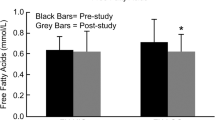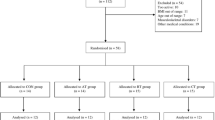Abstract
Objective: To determine the effect of exercise on chemerin in relation to changes in fat loss, insulin action, and dyslipidemia in older adults. Participants: Thirty older (65.9±0.9yr) obese adults (BMI:34.5±0.7kg/m2). Setting: Single-center, Cleveland Clinic. Design: Prospective clinical trial. Intervention: Twelve-weeks of exercise training (60minutes/day, 5day/week at ∼85% HRmax). Subjects were instructed to maintain habitual nutrient intake. Measurements: Plasma chemerin was analyzed using an enzyme-linked immunosorbent assay. Peripheral and hepatic insulin sensitivity was assessed using a euglycemic-hyperinsulinic clamp with glucose kinetics. First-phase and total glucose-stimulated insulin secretion (GSIS) was calculated from an oral glucose tolerance test. Fasting blood lipids (cholesterol, triglycerides), total/visceral fat (dual-x-ray absorptiometry and computerized tomography) and cardiorespiratory fitness (treadmill test) were also tested pre and post intervention. Results: Exercise increased fitness and reduced total/visceral fat, blood lipids, and firstphase GSIS (P<0.05). Training also increased peripheral insulin sensitivity and lowered basal/insulin-related hepatic glucose production (P<0.01). The intervention reduced chemerin (87.1±6.0 vs. 78.1±5.8ng/ml; P=0.02), and the reduction correlated with decreased visceral fat (r=0.50, P=0.009), total body fat (r=0.42, P=0.02), cholesterol (r=0.38, P=0.04), triglycerides (r=0.36, P=0.05), and first-phase and total GSIS (r=0.39, P=0.03 and r=0.43, P=0.02, respectively). Conclusions: Lower chemerin appears to be an important hormone involved in cardiometabolic risk and GSIS reduction following exercise in older adults.
Similar content being viewed by others
References
Rabe K, Lehrke M, Parhofer KG, Broedl UC. Adipokines and insulin resistance. Molecular medicine. 2008;14:741–751. doi: 10.2119/2008-00058.
Yilmaz Y, Yonal O, Kurt R, Alahdab Y, Eren F, Ozdogan O, Celikel C, Imeryuz N, Kalayci C, Avsar E. Serum levels of omentin, chemerin and adipsin in patients with biopsy-proven nonalcoholic fatty liver disease. Scand J Gastroenterol. 2011;46:91–97. doi: 10.3109/00365521.2010.516452.
Yan Q, Zhang Y, Hong J, Gu W, Dai M, Shi J, Zhai Y, Wang W, Li X, Ning G. The association of serum chemerin level with risk of coronary artery disease in Chinese adults. Endocrine. 2012;41:281–288. doi: 10.1007/s12020-011-9550-6.
Bozaoglu K, Bolton K, McMillan J, Zimmet P, Jowett J, Collier G, Walder K, Segal D. Chemerin is a novel adipokine associated with obesity and metabolic syndrome. Endocrinology. 2007;148:4687–4694. doi: 10.1210/en.2007-0175.
Tan BK, Chen J, Farhatullah S, Adya R, Kaur J, Heutling D, Lewandowski KC, O’Hare JP, Lehnert H, Randeva HS. Insulin and metformin regulate circulating and adipose tissue chemerin. Diabetes. 2009;58:1971–1977. doi: 10.2337/db08-1528.
Tonjes A, Fasshauer M, Kratzsch J, Stumvoll M, Blher M. Adipokine pattern in subjects with impaired fasting glucose and impaired glucose tolerance in comparison to normal glucose tolerance and diabetes. PLoS ONE. 2010;5:e13911-. doi:10.1371/journal.pone.0013911.
Cash JL, Hart R, Russ A, Dixon JP, Colledge WH, Doran J, Hendrick AG, Carlton MB, Greaves DR. Synthetic chemerin-derived peptides suppress inflammation through ChemR23. J Exp Med. 2008;205:767–775. doi: 10.1084/jem.20071601.
Weigert J, Neumeier M, Wanninger J, Filarsky M, Bauer S, Wiest R, Farkas S, Scherer M, Schaffler A, Aslanidis C, Scholmerich J, Buechler C. Systemic chemerin is related to inflammation rather than obesity in type 2 diabetes. Clin Endocrinol (Oxf). 2010;72:342–348. doi: 10.1111/j.1365-2265.2009.03664.x.
Shin HY, Lee DC, Chu SH, Jeon JY, Lee MK, Im J, Lee JW. Chemerin levels are positively correlated with abdominal visceral fat accumulation. Clin Endocrinol (Oxf). 2012;77:47–50. doi: 10.1111/j.1365-2265.2011.04217.x.
Sell H, Laurencikiene J, Taube A, Eckardt K, Cramer A, Horrighs A, Arner P, Eckel J. Chemerin is a novel adipocyte-derived factor inducing insulin resistance in primary human skeletal muscle cells. Diabetes. 2009;58:2731–2740. doi: 10.2337/db09-0277.
Takahashi M, Takahashi Y, Takahashi K, Zolotaryov FN, Hong KS, Kitazawa R, Iida K, Okimura Y, Kaji H, Kitazawa S, Kasuga M, Chihara K. Chemerin enhances insulin signaling and potentiates insulin-stimulated glucose uptake in 3T3-L1 adipocytes. FEBS Lett. 2008;582:573–578. doi: 10.1016/j.febslet.2008.01.023.
Becker M, Rabe K, Lebherz C, Zugwurst J, Goke B, Parhofer KG, Lehrke M, Broedl UC. Expression of human chemerin induces insulin resistance in the skeletal muscle but does not affect weight, lipid levels, and atherosclerosis in LDL receptor knockout mice on high-fat diet. Diabetes. 2010;59:2898–2903. doi: 10.2337/db10-0362.
Ernst MC, Issa M, Goralski KB, Sinal CJ. Chemerin exacerbates glucose intolerance in mouse models of obesity and diabetes. Endocrinology. 2010;151:1998–2007. doi: 10.1210/en.2009-1098.
Ernst MC, Sinal CJ. Chemerin: at the crossroads of inflammation and obesity. Trends Endocrinol Metab. 2010;21:660–667. doi: 10.1016/j.tem.2010.08.001.
You T, Nicklas BJ. Effects of exercise on adipokines and the metabolic syndrome. Curr Diab. Rep. 2008;8:7–11. doi: 10.1007/s11892-008-0003-4.
Malin SK, Niemi N, Solomon TPJ, Haus JM, Kelly KR, Filion J, Rocco M, Kashyap SR, Barkoukis H, Kirwan JP. Exercise training with weight loss and either a high-or low-glycemic index diet reduces metabolic syndrome severity in older Adults. Ann Nutr Metab. 2012;61:135–141. doi: 10.1159/000342084.
Haus JM, Solomon TPJ, Marchetti CM, Edmison JM, Gonzlez F, Kirwan JP. Free fatty acid-induced hepatic insulin resistance is attenuated following lifestyle intervention in obese individuals with impaired glucose tolerance. J Clin Endocrinol Metab. 95:323–327. doi: 2010;10.1210/jc.2009-1101.
Kelly KR, Haus JM, Solomon TPJ, Patrick Melin AJ, Cook M, Rocco M, Barkoukis H, Kirwan JP. A low-glycemic index diet and exercise intervention reduces TNF(alpha) in isolated mononuclear cells of older, obese adults. J Nutr. 2011;141:1089–1094. doi: 10.3945/jn.111.139964.
Chakaroun R, Raschpichler M, Kloting N, Oberbach A, Flehmig G, Kern M, Schron, Shang E, Lohmann T, Drebler M, Fasshauer M, Stumvoll M, Bluher M. Effects of weight loss and exercise on chemerin serum concentrations and adipose tissue expression in human obesity. Metabolism. 2012;61:706–714. doi:10.1016/j.metabol.2011.10.008.
Venojarvi M, Wasenius N, Manderoos S, Heinonen O, Hernelahti M, Lindholm H, Surakka J, Lindholm J, Aunola S, Atalay M, Eriksson JG. Nordic walking decreased circulating chemerin and leptin concentrations in middle-aged men with impaired glucose regulation. Ann Med. 2012;45(2):162–170. doi: 10.3109/07853890.2012.727020.
Saremi A, Shavandi N, Parastesh M, Daneshmand H. Twelve-week aerobic training decreases chemerin level and improves cardiometabolic risk factors in overweight and obese men. Asian J Sports Med. 2010;1(3): 151–158. PMID:22375203.
Lee MK, Chu SH, Lee DC, An KY, Park JH, Kim DI, Kim J, Hong S, Im JA, Lee JW, Jeon JY. The association between chemerin and homeostasis assessment of insulin resistance at baseline and after weight reduction via lifestyle modifications in young obese adults. Clin Chim Acta. 2013;421:109–115. doi: 10.1016/j.cca.2013.02.017.
Kim SH, Lee SH, Ahn KY, Lee DH, Suh YJ, Cho SG, Choi YJ, Hong SB, Kim Y, Jeon JY, Nam M. Effect of lifestyle modification on serum chemerin concentration and its association with insulin sensitivity in overweight and obese adults with type 2 diabetes. Clin Endocrinol (Oxf). (Epub ahead of print). 2013;doi: 10.1111/cen.12249.
Prior SJ, Joseph LF, Brandauer J, Katzel LI, Hagberg JM, Ryan AS. Reduction in midthigh low-density muscle with aerobic exercise training and weight loss impacts glucose tolerance in older men. J Clin Endocrinol Metab. 2007;92:880–886. doi: 10.1210/jc.2006-2113.
O’Leary VB, Marchetti CM, Krishnan RK, Stetzer BP, Gonzalez F, Kirwan JP. Exercise-induced reversal of insulin resistance in obese elderly is associated with reduced visceral fat. J Appl Physiol. 2006;100:1584–1589. doi: 10:1152/japplphysiol.01336.
Wolfe RR. Radioactive and stable isotope tracers in biomedicine Wiley-Liss New York, 1992.
Frayn KN. Calculation of substrate oxidation rates in vivo from gaseous exchange. J Appl Physiol. 1983;55(2):628–634.
Bateman LA, Slentz CA, Willis LH, Shields AT, Piner WL, Bales CW, Houmard JA, Kraus WE. Comparison of aerobic versus resistance exercise training effects on metabolic syndrome (from the studies of a targeted risk reduction intervention through defined Exercise — STRRIDE-AT/RT). Am J Cardiol. 2011;108:838–844. doi: 10.1016/j.amjcard.2011.04.037
Muruganandan S, Parlee SD, Rourke JL, Ernst MC, Goralski KB, Sinal CJ. Chemerin, a novel peroxisome proliferator-activated receptor gamma (PPARgamma) target gene that promotes mesenchymal stem cell adipogenesis. J Biol Chem. 2011;286:23982–23995. doi: 10.1074/jbc.M111.220491.
Muruganandan S, Roman A, Sinal CJ. Role of chemerin/CMKLR1 signaling in adipogenesis and osteoblastogenesis of bone marrow stem cells. J Bone Miner Res. 2010;25:222–234. doi: 10.1359/jbmr.091106.
Bauer S, Wanninger J, Schmidhofer S, Weigert J, Neumeier M, Dorn C, Hellerbrand C, Zimara N, Schmidhoffler A, Aslanidis C, Buechler C. Sterol regulatory elementbinding protein 2 (SREBP2) activation after excess triglyceride storage induces chemerin in hypertrophic adipocytes. Endocrinology. 2011;152:26–35. doi: 10.1210/en.2010-1157.
Jialal I, Devaraj S, Kaur H, Adams Huet B, Bremer AA. Increased chemerin and decreased omentin-1 in both adipose tissue and plasma in nascent metabolic Syndrome. J. Clin Endocrinol Metab. 2013;98(3):E514–E517. doi: 10.1210/jc.2012-3673.3673.
Goralski KB, McCarthy TC, Hanniman EA, Zabel BA, Butcher EC, Parlee SD, Muruganandan S, Sinal CJ. Chemerin, a novel adipokine that regulates adipogenesis and adipocyte metabolism. J Biol Chem. 2007;282:28175–28188. doi: 10.1074/jbc.M700793200.
Pei L, Yang J, Du J, Liu H, Ao N, Zhang Y. Downregulation of chemerin and alleviation of endoplasmic reticulum stress by metformin in adipose tissue of rats. Diabetes Res Clin Pract. 2012;97:267–275. doi: 10.1016/j.diabres.2012.02.023.
Chu SH, Lee MK, Ahn KY, Im JA, Park MS, Lee DC, Jeon JY, Lee JW. Chemerin and adiponectin contribute reciprocally to metabolic syndrome. PLoS ONE. 2012;7:e34710–e34710. doi: 10.1371/journal.pone.0034710.
Kralisch S, Weise S, Sommer G, Lipfert J, Lossner U, Bluher M, Stumvoll M, Fasshauer M. Interleukin-1beta induces the novel adipokine chemerin in adipocytes in vitro. Regul Pept. 2009;154:102–106. doi: 10.1016/j.regpep.2009.02.010.
Herenius MM, Oliveira AS, Wijbrandts CA, Gerlag DM, Tak PP, Lebre MC. Anti-TNF therapy reduces serum levels of chemerin in rheumatoid arthritis: a new mechanism by which anti-TNF might reduce inflammation. PLoS One. 2013;8(2):e57802. doi: 10.1371/journal.prone.0057802.
Ouwens DM, Bekaert M, Lapauw B, Van Nieuwenhove Y, Lehr S, Hartwig S, Calders P, Kaufman JM, Sell H, Eckel J, Ruige JB.Chemerin as biomarker for insulin sensitivity in males without typical characteristics of metabolic syndrome. Arch Physiol Biochem. 2012;118:135–138. doi: 10.3109/13813455.2012.654800.
Bauer S, Bala M, Kopp A, Eisinger K, Schmid A, Schneider S, Neumeier M, Buechler C. Adipocyte chemerin release is induced by insulin without being translated to higher levels in vivo. Eur J Clin Invest. 2012;42:1213–1220. doi: 10.1111/j.1365-2362.2012.02713.x.
Kalyani RR, Varadhan R, Weis CO, Fried LP, Cappola AR. Frailty status and altered dynamics of circulating energy metabolism hormones after oral glucose in older women. J Nutr Health Aging. 2012;16(8):679–686. doi: 10.1007/s12603-012-0369-5.
Moreira PF, Dalboni MA, Cendorogio M, Santos GM, Cendorogio MS. Postprandial interleukin-6 response in elderly with abdominal obesity and metabolic syndrome. J Nutr Health Aging. 2013;17(3):206–210. doi: 10.1007/s12603-012-0400-x.
Little JP, Safdar A, Benton CR, Wright DC. Skeletal muscle and beyond: the role of exercise as a mediator of systemic mitochondrial biogenesis. Appl Physiol Nutr Metab. 2011;36(5):598–607. doi: 10.1139/h11-076.
Ryan AS, Nicklas BJ. Exercise with calorie restriction improves insulin sensitivity and glycogen synthase activity in obese postmenopausal women with impaired glucose tolerance. Am J Physiol Endocrinol Metab. 2004;302(1):E145–E152. doi: 10.1152/ajpendo.00618.2010.
Roman AA, Parlee SD, Sinal CJ. Chemerin: a potential endocrine link between obesity and type 2 diabetes. Endocrine. 2012;42:243–251. doi: 10.1007/s12020-012-9698-8.
Bloem CJ and Chang AM. Short-term exercise improves beta-cell function and insulin resistance in older people with impaired glucose tolerance. J.Clin.Endocrinol.Metab. 2008;93:2:387–392. doi: 10.1210/jc.2007-1734
Solomon TPJ, Haus JM, Kelly KR, Rocco M, Kashyap SR and Kirwan JP. Improved pancreatic beta-cell function in type 2 diabetic patients after lifestyle-induced weight loss is related to glucose-dependent insulinotropic polypeptide. Diabetes Care 2010;33:7:1561–1566. doi: 10.2337/dc09-2021.
Kelly KR, Brooks LM, Solomon TP, Kashyap SR, O’Leary VB, Kirwan JP. The glucose-dependent insulinotropic polypeptide and glucose-stimulated insulin response to exercise training and diet in obesity. Am J Physiol Endocrinol Metab. 2009;296(6):E1269–E1274. doi: 10.1152/ajpendo.00112.2009.
DeFronzo RA and Abdul Ghani MA. Preservation of ß-cell function: the key to diabetes prevention. J.Clin.Endocrinol.Metab. 2011;96:8:2354–2366. doi: 10.1210/jc.2011-0246.
Takahashi M, Okimura Y, Iguchi G, Nishizawa H, Yamamoto M, Suda K, Kitazawa R, Fujimoto W, Takahashi K, Zolotaryov FN, Hong KS, Kiyonari H, Abe T, Kaji H, Kitazawa S, Kasuga M, Chihara K, Takahashi Y. Chemerin regulates β-cell function in mice. Sci Rep. 2011;1:123. doi: 10.1038/srep00123.
Cobelli C, Toffolo GM, Dalla Man C, Campioni M, Denti P, Caumo A, Butler P and Rizza R. Assessment of beta-cell function in humans, simultaneously with insulin sensitivity and hepatic extraction, from intravenous and oral glucose tests. Am J Physiol Endocrinol Metab. 2007;293:1:E1–E15. doi:10.1152/ajpendo.00421.2006.
Author information
Authors and Affiliations
Corresponding author
Rights and permissions
About this article
Cite this article
Malin, S.K., Navaneethan, S.D., Mulya, A. et al. Exercise-induced lowering of chemerin is associated with reduced cardiometabolic risk and glucose-stimulated insulin secretion in older adults. J Nutr Health Aging 18, 608–615 (2014). https://doi.org/10.1007/s12603-014-0459-7
Received:
Accepted:
Published:
Issue Date:
DOI: https://doi.org/10.1007/s12603-014-0459-7




